Getting a Grip on the Grippe.
COVID-19: Going Viral On a Global Scale (Premise).
March 14, 2020—To trip, or just sit and grip? That is the question as a novel COVID-19 virus spreads globally like fearsome outbreaks of yore. It’s not quite the Bubonic Plague, Black Death or Spanish Influenza of 1918/19 yet, but the P-word has been declared, and the world is anxiously waylaid.
19th Nervous Lockdown.
Citizens and passengers displaying symptoms are being detained on ships or fenced off in camp 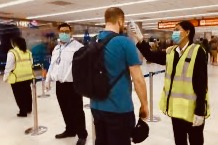 quarantines. Cities, regions, whole countries across Europe are sealing off, clamping down—as well as Great Britain and Ireland. Cruise ships are turning into floating pestilence incubators, airline flights are half-full, fleets are being grounded sans notice.
quarantines. Cities, regions, whole countries across Europe are sealing off, clamping down—as well as Great Britain and Ireland. Cruise ships are turning into floating pestilence incubators, airline flights are half-full, fleets are being grounded sans notice.
Ancillary businesses, from airport stands to tourist shops, are only beginning to feel the economic pain. Community transmission scenarios like shows and events, major and minor (like SXSW), are scaling back if not cancelling; sports will soon be played out to empty arenas, if at all.
Even in this time of more zealous nationalistic retrenchment, the Coronavirus pandemic only demonstrates that the world no longer has impenetrable borders. In reaction, the blame falls on today’s global interconnectedness, be it communication—air, surface and cruise travel—or international industrial supply chains.
So, what’s up with that?
Disease and Desist?
To refresh, this post-SARS (Severe Acute Respiratory Syndrome)-Cov-2 virus strain was initially identified in Wuhan by the Chinese government around early December, 2019.
Since named COVID-19, it appears to be an RNA virus with spiked crown edges that can cause acute flu-like symptoms, respiratory distress—most severely a double-lung infection leading perhaps to death in 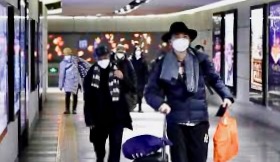 those most autoimmune vulnerable (especially toddlers and the elderly). This Coronavirus has thus far been rapidly escaping containment, as Europe and the Seattle area can well attest.
those most autoimmune vulnerable (especially toddlers and the elderly). This Coronavirus has thus far been rapidly escaping containment, as Europe and the Seattle area can well attest.
Moreover, with a 2-21 day incubation period, its human carriers may be undetected so not know it, a single person possibly transmitting to 3-4 others, before COVID symptoms actually full-blown take them down. And any vaccine to this latest strain is said to be months or a year away.
In the meantime, the World Health Organization has officially declared it a pandemic, and the U.S. Centers for Disease Control (CDC) has issued a 3-level warning protocol regarding the COVID-19 threat:
- Places and events are put on watch if virus has not spread widely.
- Enhanced precautions expand to Level 2—say, for countries like Italy, Japan, Iran.
- High level: avoid non-essential travel.
Bottom line, CDC officials advise, ‘If you’re sick, don’t trip’.
Nonetheless, the budget-weakened CDC does offer information on overseas healthcare, advising, for example, that U.S. embassies and consulates have no legal authority to give medicine/vaccines or medical care to private U.S. citizens abroad. CDC advisories can be fluid, sometimes conflicting—from travel warnings on Japan, Italy and Iran to requiring that airline crews isolate any ill passengers, to estimating overseas risks of quarantine and the confinement. Yet their notices are nowhere near as inscrutable as the TSA list of onboard bring-alongs.
To-Do’s and Do-Too’s.
Along those lines, it is clinically acknowledged that this virus spreads via droplets transmitted through coughs and sneezes to nearby (within six feet) mouths and noses.
Beyond the by now well-established precautions of washing hands (20-second scrubbing recommended, as with sanitizers); keeping hands off the face and eyes; wearing N95+ masks (better indoors than out), regularly taking temperature readings, other do’s and don’t’s include:
- Do stock up on Vitamin C, prescription medicines, painkillers and decongestants.
- Have plenty of disposable tissue; if necessary, sneeze into sleeves.
- Do extra clean assigned onboard (aircraft, etc.) seating on your own; close or re-aim overhead vents.
- Check the fine print on your travel/health insurance policies.
- Avoid touching others, or being in touch, or wear gloves, replacing or washing them daily.
- That is, don’t hug or shake hands, better to use Ebola era elbow bumps—and no face touching!
- Don’t touch doorknobs, elevator buttons, hotel facilities without gloves, and wipe down surfaces.
- No public kissing, cheeks and all; take care in sharing drinks and food.
- Flush toilets with lids closed (re: feces contamination).
- Don’t buy, slaughter or consume live animals or fish until the virus source species is identified (assuming COVID-19 is not product of a bioweapons lab)—a little levity there.
…And so on. In other words, no travel, no crowds, no undue breathing! But just try to keep from touching your face for more than two minutes…
Nevertheless, since those virus droplets are determined by health officials to transmit person to person within 6 feet of one another, we are further warned to stay away from crowds. That includes transit vehicles, airports, train stations, restaurants, clubs, shows, stadiums and shopping malls, etc.—any means of community transmission; instead we are told to practice social distancing and avoid congregate gatherings, thereby ‘flattening the curve’.
Homing in on Repercussions.
Black swans flocking in: the U.S. Travel Association foresees international inbound traffic dropping by at least 6% between now and May; the Global Business Travel Association sees a 13% slowdown in domestic 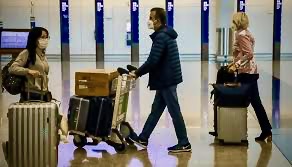 and international travel (bookings now down 25-35%). The USTA also warns of a trickle-down effect on tourism, restaurants and hotels as the result of this worldwide ‘fear event’, worst since 9/11, with recovery months, if not years away.
and international travel (bookings now down 25-35%). The USTA also warns of a trickle-down effect on tourism, restaurants and hotels as the result of this worldwide ‘fear event’, worst since 9/11, with recovery months, if not years away.
Cruise lines (now scorned as pestilence factories) are porting/docking in place around the world. The airline industry fears upwards of a $113b hit on revenues amid a Corona crash in air travel. For their part, airlines seem to be blaming ‘media’ coverage for the ‘breathtaking’ velocity and severity of the air travel plunge by sowing ‘confusion and false narratives’. Carriers and cruise lines alike hold that the risk of corona virus transmission remains low for travelers who follow CDC guidelines, save for older passengers with pre-existing medical conditions.
On the surface, carriers may report they are redoubling efforts to clean their planes—vacuuming carpets to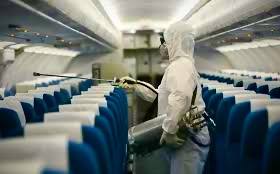 disinfectant wipedowns of seats, tray tables, screens and headrests. Viraclean liquid cleanser and Premium Purity spray-on film tackled microbes and filter/purify cabin air: for all intents and purposes, hospital-grade sanitizing.
disinfectant wipedowns of seats, tray tables, screens and headrests. Viraclean liquid cleanser and Premium Purity spray-on film tackled microbes and filter/purify cabin air: for all intents and purposes, hospital-grade sanitizing.
But scratching deeper, carriers are seeing more half-empty aircraft by the day, parking aircraft, slashing operating expenses, paring flight crews, ground staff and upper management as traffic drops by up to 70%. Meanwhile travelers rushing to alter plans are bumping up against onerous change/cancellation penalties and ‘virus’ fees.
Flexible Flyers in Rougher Sledding?
Carriers like Delta (cutting schedules 40%), Southwest, American—over to Ryanair and Lufthansa—all caught in this sudden Corona demand spiral—are reluctant to lose ticket and fee revenue. United, dropping 15% of domestic, 25% of international flights, initially pushed to rebook cancelled passengers on alternative flights within two hours, meaning that 90% of its change customers would not qualify for a credit/ticket refund. UAL has since fudged some on this hardball tactic (so travelers must rebook quickly—tough planning-wise in these uncertain times), and is now offering non-refundable tickets without change or cancellation fees.
More drastically, some airlines continue suspending and/or cancelling flights with little or no notice, scaling back, cutting costs from tarmac to corporate towers, if they can even survive. Worse, British regional carrier, FLYBE has gone belly up altogether upon losing financial support—stranding passengers, unlikely to refund tickets that aren’t part of a full holiday package. Where have we suffered through this before?
Other carriers, domestic and international, are becoming more flexible as well, waiving C&C surcharges for the immediate future (March through April). While cruise lines are proving to be rather more consumer 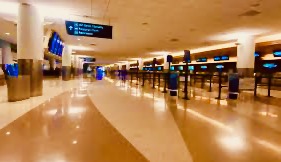 friendly on timely refunds. No such luck with hotels, Air BnB’s and third-party ticket sellers. On the plus side, carriers are resorting (however reluctantly) to cheaper tickets to prop up flagging traveler demand, dropping fares 14% to 70% going forward into mid-March, while slipping in qualifying fees where they can. Still, carriers are shutting down, grounding en masse.
friendly on timely refunds. No such luck with hotels, Air BnB’s and third-party ticket sellers. On the plus side, carriers are resorting (however reluctantly) to cheaper tickets to prop up flagging traveler demand, dropping fares 14% to 70% going forward into mid-March, while slipping in qualifying fees where they can. Still, carriers are shutting down, grounding en masse.
At the same time, airports are grappling with terminals devoid of people, shops, restaurants and lounges boarding up like ghost towns. Travelers who do brave concourses and TSA checkpoints are subject to lightning temperature scans; cough and sneezers face further screening and isolation, if not two weeks of quarantine.
Little wonder the airline industry is joining cruise lines in calling for tax breaks, bailout subsidies and other targeted government assistance, plus relief on ‘Use It or Lose It’ airport slot rules requiring 80% occupation to ensure slot allocations into next year. Time will tell how far that aid takes them through this Corona storm.
One indication is the Trump administration’s unilateral announcement to wall off travel from Europe to the U.S., followed by various fumbling corrections and walkbacks, a 30-day ban affecting millions of travelers, mainly foreign nationals from 26 EU Schengen countries, the UK and Ireland. An inbound rush has resulted in humongous, hourslong (customs) waitlines at 13 U.S. airports for per-person health testing/screening—quite the ‘hoax and con job’, all right…
Go Fetal or Go Forth.
So, what now, and where? Hunker down for the pandemic’s duration or Hanker for a trippy little escapade?
Whichever, pump the brakes a moment, mates, pump those brakes. Because this Corona crisis does not pose a binary situation; meaning, travel is not simply a safe versus unsafe proposition.
The arguments vary. To some, travel is a viral Petri dish—too much mixed mingling in too close quarters. Others counter there is no conclusive proof air travel increases Corona transmission; besides, travel restrictions have not exactly worked thus far.
To be sure, COVID-19 is spreading at an unprecedented rate, and even with a possible warm weather easing, it could prove to be re-emergent come the fall. Mobil healthcare and detainment/quarantine fears  do in fact loom, and an anti-viral vaccine could be months, if not a year away. Still, most healthy people are said to be at low risk for contracting this disease, and life must go on somehow—hot spots or no.
do in fact loom, and an anti-viral vaccine could be months, if not a year away. Still, most healthy people are said to be at low risk for contracting this disease, and life must go on somehow—hot spots or no.
So ultimately we will assess our own risk tolerance. If we’re ill, separation and self-isolation may well be in order. Absent that, let’s pack up our troubles in our ol’ grip bags, get out of our easy chairs and get out there. Even on the off chance we should feel the peak of global air and sea travel has now passed, we can always wash our hands of it all, ride the drop in petrol prices and hit the open road by motor car.
In any case, rest assured Vamigré will be our Corona recovery vehicle along the way. (MMTC…)
